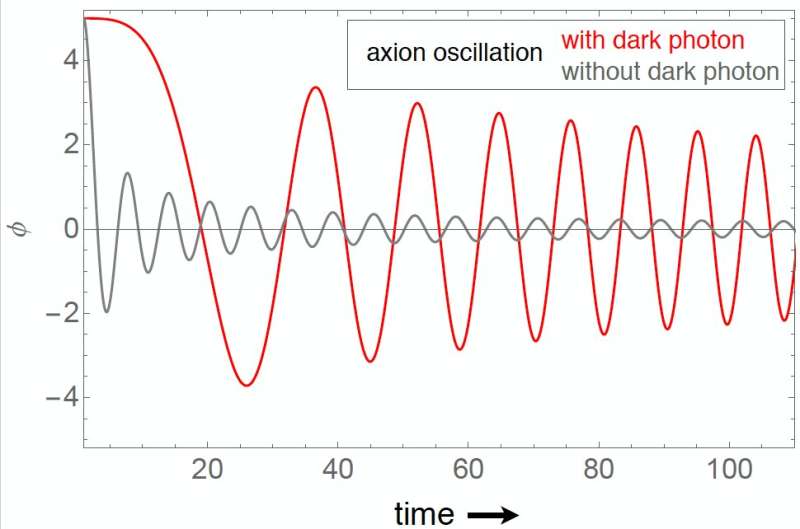Figure illustrating the difference in evolution of the axion with and without the mixing with the dark photon. Credit: Hook, Marques-Tavares & Tsai.
Axions and dark photons are two of the most promising types of particles for unveiling new physics. The axion scalar field explains the absence of an electric dipole moment for the neutron, while the dark photon resembles regular photons responsible for electromagnetism, but it is massive and much more weakly coupled.
In the past, many cosmologists investigating dynamics in the early universe proposed theories that focused either on axions or dark photons. Research exploring the interactions between these two types of particles in the early universe, on the other hand, is still scarce.
With this in mind, researchers at University of Maryland and Johns Hopkins University recently carried out a study aimed at investigating the interplay between axions and dark photons in the early universe. Their paper, published in Physical Review Letters, examines a series of examples in which an axion mixes with a massive dark photon within a background magnetic field.
"While there is a large body of literature on the cosmological evolution of theories with only one of those two particles, we were interested in understanding how the interplay of both of those particles in the early universe could lead to new features and ended up finding very interesting behavior associated with their mixing," Gustavo Marques-Tavares, one of the researchers who carried out the study, told Phys.org. "The new effects we observed were drastically different from other more commonly considered types of mixing."
First of all, Marques-Tavares and his colleagues set out to develop a physical hypothesis or intuition. To do this, they solved a simplified version of specific equations typically applied to complex analytic problems.
Once they came up with a physical intuition, they used two mathematical techniques known as WKB approximation and adiabatic approximation to attain a set of possible solutions to the problem they were focusing on. The researchers then compared the approximate solutions they identified with exact numerical solutions and found that the two matched fairly well.
Overall, they suggest that single derivative mixing between massive bosonic fields could prompt substantial changes in the field dynamics. More specifically, it could delay the onset of classical oscillations, decreasing and perhaps even eliminating the friction resulting from the Hubble expansion, which is the rate at which the universe is expanding. The researchers further described the phenomenon they examined using a number of examples, which highlighted possibilities arising from the interplay between axions and dark photons.
"In many ways, light scalar and vector fields behave more like classical fields than quantum particles in their cosmological evolution," Marques-Tavares said. "We found that our method greatly enhances the amplitude of the axion compared to a theory that does not include the mixing with a dark photon. Because the energy density stored in the field grows with its amplitude, this leads to a larger final energy density for the axion, allowing it to explain all of the dark matter in the universe."
The recent work by this team of researchers introduces calculations that highlight the effects of single derivative mixing between axions and dark photons, as opposed to the more typical mass mixing or kinetic mixing. The results presented by Marques-Tavares and his colleagues also highlight new directions for future research aimed at better understanding the effects of single-derivative mixing between particles, particularly in the early universe. In their next studies, the researchers plan to study dark photons more closely, as they are easy to observe and have thus become popular dark matter candidates.
"Dark photons are notoriously tricky to produce in the early universe, and thus, it is challenging for them to explain all of dark matter," Marques-Tavares said. "The same mechanism that allows us to enhance the number of axions can also be used to increase the number of dark photons, allowing them to become a dark matter candidate. We plan on exploring this new mechanism we proposed applied to dark photons."
More information: Anson Hook et al. Scalars Gliding through an Expanding Universe, Physical Review Letters (2020). DOI: 10.1103/PhysRevLett.124.211801
Journal information: Physical Review Letters
© 2020 Science X Network
























